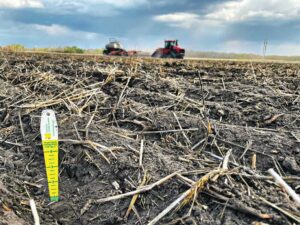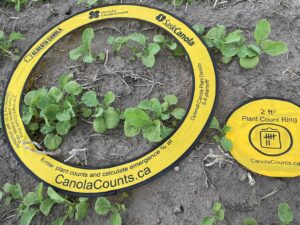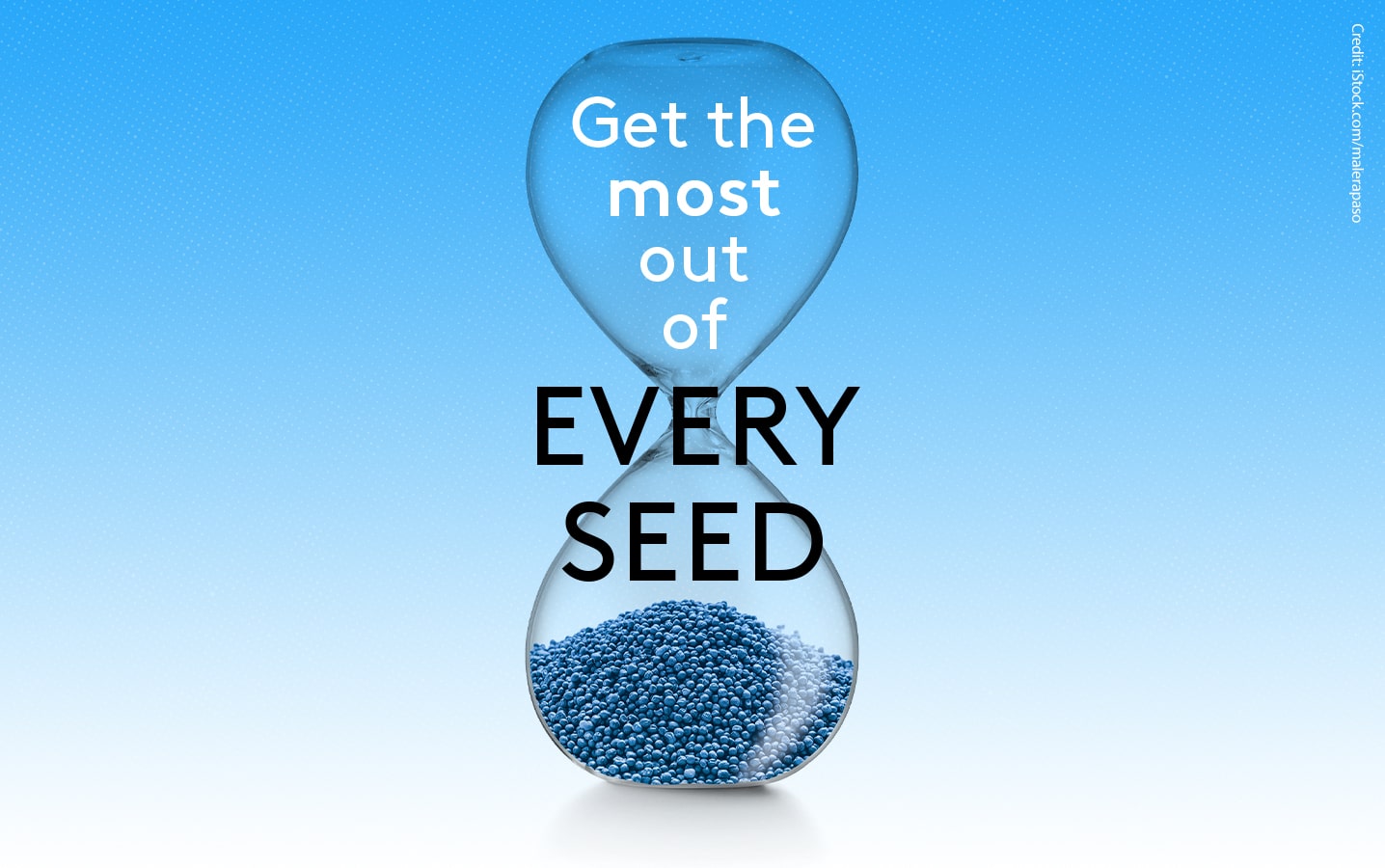Get the most out of every seed
Weather challenges in 2021 could leave canola seed in short supply for 2022, forcing farmers to up their game to get as much as possible out of what’s available.
Growers who are planning to grow specific canola hybrids should make their intentions known to their canola seed retailer sooner than later to improve their chances of getting the specific canola cultivar they wish to seed on the farm, says Canola Council of Canada (CCC) agronomy specialist Jason Casselman.
Maximize seed emergence
More than usual, growers also need to key in on how to improve seed emergence, which is typically only 50 to 60 percent. The CCC has these recommendations:
Avoid tight canola rotations.
Fields without at least a two-year break between canola crops can result in heightened seed and seedling diseases that may prevent emergence or weaken young plants.
Seed shallow.
Seed depth of half an inch to one inch below the packer furrow reduces both emergence time and the energy that seeds expend to emerge.
Seed at a consistent depth.
Variable depths can result in highly variable emergence dates and an uneven field. Casselman says a field with plants at different growth stages can create yield and quality losses simply due to inability to time applications that align with all the plants. CCC recommends following the operator’s manual to level the drill, ensure openers are in good shape, and inflate tires to the same pressure.
Walter Gross of Fort MacLeod, Alberta, found a 2.5-bushel difference from reducing speeds by just one mile per hour. “You need to find the right speed for your field for your equipment, and that will vary from one field to the other.”
Seed slower.
Rear openers tend to throw more soil over the front rows at higher speeds, causing those seeds to emerge slower. Higher speeds also result in the seeding tool cutting less smoothly, including seed rows.

consistent depth of half an inch to one inch below the packer furrow tend to have reduced emergence time, more uniform emergence, more vigour and longer protection from seed treatments.
Walter Gross, farm manager with Greenwood Colony at Fort MacLeod, Alberta, has achieved 80-plus per cent canola seed emergence for the past few years.
In his own yield trials, Gross found a 2.5-bushel difference from reducing speeds by just one mile per hour. “You need to find the right speed for your field for your equipment, and that will vary from one field to the other,” he says.
Gross also stresses making sure the fan speed is right for the product being put down. “If you’re running 24 hours, you will need to increase or decrease your fan speed as ambient conditions change, to get uniform seed delivery due to changes in humidity.”
Limit seed-placed fertilizer.
“‘Set it and forget it’ does not work well on our farm, packing pressure needs to be evaluated and optimized frequently as field conditions can change rapidly.”
Walter Gross
To reduce seedling mortality, the safest approach is to place only phosphate fertilizer with the seed at rates up to 20 pounds of phosphate per acre. Higher rates might still be safe if there’s higher soil moisture, which could protect seedlings somewhat.
Gross places monoammonium phosphate in the seed row and nitrogen and sulphur in the mid-rows. “We’re definitely not burning our seed with what we’re putting beside it,” he says. “It’s just enough to get it started.”
Penetrate residue.
Use openers and drill settings that penetrate residue to ensure all seeds are planted in the soil. Gross says seed placement is critical, especially for something as shallow-seeded as canola. His Bourgault seeding tools are both on 10-inch row spacing with a two-inch opener.
“While the industry says a narrow three-quarter-inch knife gives you more control over your seed because the knife will cut a nicer groove, we found that the two-inch opener in our soil conditions gives us better seedbed utilization,” says Gross.
Before seeding commences, ensure residue is already spread evenly across the soil surface. “You have to manage residue the year before really well before you can get an accurate, ideal seed placement the following year,” Gross says. Otherwise, he warns, there’ll be emergence challenges.
“We harvest at an angle, so that when we go through residue, you’re not following the residue path that the combine left, and you’re not plugging those four or five shanks where the swath was,” Gross says. They generally seed north and south, and harvest at about an 80-degree angle. “It’s smooth and your drill is always running through the residue or the chaff swath, whatever’s remaining that the combine couldn’t spread. You’re not following the same swath.”
Pack according to conditions.
Reduce packing pressure in wet conditions to limit hard crusting, but pack more in dryness to conserve moisture. “ ‘Set it and forget it’ does not work well on our farm,” says Gross. “Packing pressure needs to be evaluated and optimized frequently as field conditions can change rapidly.”
Gross adds that with all the wind in his area, if the soil on top of the seed is too loose, it can dry out readily, causing many seeds to die after germination.
Seed into warmer soils.
Soil temperatures of 5°C or higher will facilitate reasonably good rates of emergence.
Casselman advises evaluating your canola plant stand at the two-to-four leaf stage. At this point, you can determine seed survival, discover possible opportunities to improve or maintain management decisions, as well as factors related to plant establishment and achieving agronomic goals.

He notes that Canola Counts, the crowd-sourced survey tool CCC launched in spring 2021, can be accessed again this spring through canolacalculator.ca or directly at canolacounts.ca.
“The survey tool maps canola plant densities and emergence percentages from grower and agronomist input, while helping to drive the adoption of regular plant counts as an important step in achieving target yields,” Casselman says.
Maximize yield
Rapid canopy cover is key to intercept as much light energy as possible. “Anything that slows down that time to light interception, or prevents full light interception from happening, will result in a yield loss.”
–Steve Shirtliffe
CCC recommends targeting a canola plant population of five to eight plants per square foot.
This provides maximum yield potential while providing some buffer for plant loss due to post-seeding stresses like frost, seedling disease, weather, insects, and weed competition, Casselman says.
Canola plants in low population density situations grow larger and branch more, and tend to mature later, making it more likely they’ll encounter a fall frost that can prevent the development of immature seed, he says. This will cause shrivelled seeds and higher chlorophyll levels, ultimately leading to reduced grade or lost yield, Casselman explains.
University of Saskatchewan researcher Steve Shirtliffe notes seeding densities tend to matter most when conditions are dry.
“When growth conditions are dry, what you see is that the crop canopy can’t compensate as quickly,” Shirtliffe says. “We tend to get more of a response to seeding rates under dry conditions.”
Canopies are key.
Typically, the more light that a canopy intercepts, the higher the yield.
“Anything that slows down that time to light interception, or prevents full light interception from happening, will result in a yield loss,” Shirtliffe says.
He recommends row spacing no wider than 12 inches: “Any time you get wider than 12 inches, you’ll start to see some small declines.”





